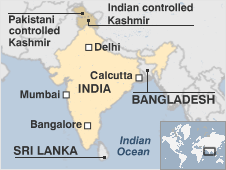 |
The world's largest democracy and second most populous country emerged as a major power in the 1990s. It is militarily strong has a big cultural influence and a fast-growing and powerful economy.
A nuclear weapons state it carried out tests in the 1970s and again in the 1990s in defiance of world opinion. However India is still tackling huge social economic and environmental problems.
Overview
The vast and diverse Indian sub-continent - from the mountainous Afghan frontier to the jungles of Burma - was under foreign rule from the early 1800s until the demise of the British Raj in 1947.
AT-A-GLANCE
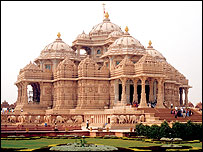 Economy: Fast-growing economy; large skilled workforce but widespread poverty
Politics: 344m people voted in 2009 election - Congress-led alliance of PM Manmohan Singh won second mandate
International: Ongoing dispute with Pakistan over Kashmir region; nuclear weapons state; world's most prolific film industry - Bollywood
|
The subsequent partition of the sub-continent - into present-day India and Pakistan - sowed the seeds for future conflict. There have been three wars between India and its arch-rival Pakistan since 1947 two of them over the disputed territory of Kashmir.
A peace process which started in 2004 stayed on track despite tension over Kashmir and several high-profile bombings until the Mumbai attacks of November 2008 which police blamed on Pakistani militants. India announced that the process was on pause the following month.
Communal caste and regional tensions continue to haunt Indian politics sometimes threatening its long-standing democratic and secular ethos.
In 1984 Prime Minister Indira Gandhi was gunned down by her Sikh bodyguards after ordering troops to flush out Sikh militants from the Golden Temple in Amritsar.
And in 1992 widespread Hindu-Muslim violence erupted after Hindu extremists demolished the Babri mosque at Ayodhya.
Independent India's first prime minister Jawaharlal Nehru dreamed of a socialist society and created a vast public infrastructure much of which became a burden on the state.
From the late 1980s India began to open up to the outside world encouraging economic reform and foreign investment. It is now courted by the world's leading economic and political powers including its one-time foe China.
The country has a burgeoning urban middle class and has made great strides in fields such as information technology. Its large skilled workforce makes it a popular choice for international companies seeking to outsource work.
But the vast mass of the rural population remains impoverished.
Their lives continue to be influenced by the ancient Hindu caste system which assigns each person a place in the social hierarchy. Discrimination on the basis of caste is now illegal and various measures have been introduced to empower disadvantaged groups and give them easier access to opportunities - such as education and work.
Poverty alleviation and literacy campaigns are ongoing.
Nuclear tests carried out by India in May 1998 and similar tests by Pakistan just weeks later provoked international condemnation and concern over the stability of the region.
The US quickly imposed sanctions on India but more recently the two countries have improved their ties and even agreed to share nuclear technology.
India launches its own satellites and in 2008 sent its first spacecraft to the moon. It also boasts a massive cinema industry the products of which are among the most widely-watched films in the world.
Facts
- Full name: Republic of India
- Population: 1.2 billion (UN 2009)
- Capital: New Delhi
- Most-populated city: Mumbai (Bombay)
- Area: 3.1 million sq km (1.2 million sq miles) excluding Indian-administered Kashmir (100 569 sq km/38 830 sq miles)
- Major languages: Hindi English and at least 16 other official languages
- Major religions: Hinduism Islam Christianity Sikhism Buddhism Jainism
- Life expectancy: 62 years (men) 65 years (women) (UN)
- Monetary unit: 1 Indian Rupee = 100 paise
- Main exports: Agricultural products textile goods gems and jewellery software services and technology engineering goods chemicals leather products
- GNI per capita: US $1070 (World Bank 2008)
- Internet domain: .in
- International dialling code: +91
Leaders
President: Pratibha Patil
Pratibha Patil became India's first female president in July 2007 after being voted into office by members of state assemblies and the national parliament.
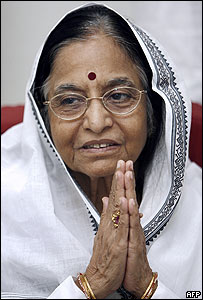
President Pratibha Patil
|
Mrs Patil the candidate of the ruling Congress Party was previously the little-known governor of the northwestern desert state of Rajasthan. She drew criticism during the campaign over scandals involving family members and over controversial remarks.
Supporters hailed her election as a victory for women but critics wondered how much influence she would have.
India has had several women in powerful positions - most notably Indira Gandhi one of the world's first female prime ministers in 1966 - but activists complain that women still face widespread discrimination.
Mrs Patil succeeds APJ Abdul Kalam a scientist and the architect of the country's missile programme.
Indian presidents have few actual powers but they can decide which party or individual should form the central government after general elections.
Prime minister: Manmohan Singh
Mr Singh became prime minister in May 2004 after the Congress Party's unexpected success in general elections.
The party's president Sonia Gandhi the widow of former prime minister Rajiv Gandhi shocked her supporters by declining the top post apparently to protect the party from damaging attacks over her Italian origin.
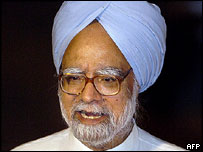 PM Singh took office after Sonia Gandhi turned down the job
|
Mr Singh said his priorities were to reduce poverty and to plough on with economic reforms. He stated a desire for friendly relations with India's neighbours especially Pakistan.
During his first year in office he held together a coalition which included communist allies and ministers accused of corruption. He continued to pursue market-friendly economic policies and oversaw the introduction of nuclear non-proliferation legislation.
But his promised "New Deal" for rural India - an attempt to raise the poorest citizens out of poverty - has still to bear fruit.
Manmohan Singh's government also came under intense pressure after the Mumbai attacks of November 2008 which left nearly 200 people dead and prompted a storm of criticism of security arrangements.
However Mr Singh's Congress-led coalition scored an emphatic victory at general elections in April and May 2009 coming within 11 seats of winning an absolute majority in parliament.
The emphatic defeat of the opposition Bharatiya Janata Party (BJP) confounded predictions of a close contest.
While still needing the support of some smaller parties the government looked to be in a much stronger position to pursue economic reforms particularly against opposition from left.
Mr Singh made his reputation as a finance minister in the early 1990s under the Narasimha Rao government when he was the driving force behind economic liberalisation.
When the Congress Party was voted out of office Mr Singh became opposition leader in the upper house.
A Sikh born in West Punjab Mr Singh is a former International Monetary Fund official and governor of India's Central Bank. He was educated at Oxford and Cambridge.
Media
Indian broadcasting has flourished since state TV's monopoly was broken in 1992. The array of channels is still growing.
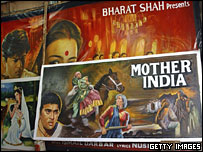 Billion-dollar film industry produces hundreds of movies each year
|
Private cable and satellite stations command large audiences. News programmes often outperform entertainment shows. Many 24-hour news channels are up and running and more are planned.
Doordarshan the public TV operates 21 services including its flagship DD1 channel which reaches some 400 million viewers.
Multichannel direct-to-home (DTH) TV has been a huge hit. Five operators - Dish TV Tata-Sky Sun Direct Big TV and Airtel Digital TV - have attracted millions of subscribers. State-owned Doordarshan Direct offers a free-to-air DTH service.
Some industry sources say the number of DTH subscribers could reach 60 million by 2015. The cable TV market is one of the world's largest.
Since they were given the green light in 2000 music-based FM radio stations have proliferated in the cities. But only public All India Radio can broadcast news.
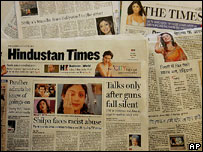
Established newspapers are slugging it out with new rivals
|
India's press is lively. Driven by a growing middle class newspaper circulation has risen and new titles compete with established dailies.
Internet use has soared; by September 2007 around 60 million Indians were online (ITU figure).
Paris-based Reporters Without Borders says press freedom is threatened by "the violence of political parties as well as religious and separatist groups" (India - Annual report 2008).
The press
- Deccan Herald - Bangalore-based daily
- The Hindu - Madras-based daily
- The Hindustan Times - New Delhi-based daily
- The Pioneer - New Delhi-based daily
- The Indian Express - New Delhi-based daily
- The Statesman - Calcutta-based daily
- The Times of India - Mumbai-based daily
- The Asian Age - New Delhi-based daily
- India Today - New Delhi-based news magazine
- Outlook - New Delhi-based news magazine
Television
- Doordarshan Television - public TV; operates national regional local and satellite services
- Zee TV - satellite cable TV services operated by Zee Group
- STAR TV - operates satellite cable TV services including STAR News owned by News Corporation
- Sony Entertainment TV - commercial channel
- Aaj Tak - 24-hour news in Hindi
- New Delhi TV (NDTV) - operates NDTV-India and NDTV 24x7 news channels
- Sun Network - commercial multi-channel broadcaster
Radio
- All India Radio - public operates domestic and external networks
- Radio Mirchi - commercial network stations in Mumbai Delhi and other cities mainly music operated by The Times Group
- Radio City - commercial FM stations in Delhi Mumbai and other cities owned by News Corporation
- Red FM - commercial operated by India Today Group
News agency
-
Press Trust of India - non-profit owned by newspaper titles
AFRICA | ASIA-PACIFIC | AMERICAS | EUROPE | MIDDLEEAST | SOUTHASIA
Mauritania Mauritius Morocco Mozambique Namibia Niger Nigeria Republic-of-congo Rwanda Sao-tome-and-principe Senegal Seychelles Sierra-leone Somalia South-africa Sudan Swaziland Tanzania The-gambia Togo Tunisia Uganda zambia Zimbabwe Australia Brunei Burma Cambodia China East-timor Fiji Indonesia Japan Kazakhstan Kiribati Kyrgyzstan Laos Malaysia Marshall-islands Micronesia Mongolia Nauru New-zealand North-korea Palau Papua-new-guinea Samoa Singapore Solomon-islands South-korea Taiwan Tajikistan Thailand The-philippines Tonga Turkmenistan Tuvalu Uzbekistan Vanuatu Vietnam Antigua-and-barbuda Argentina Bahamas Barbados Belize Bolivia Brazil Canada Chile Colombia Costa-rica Cuba Dominica Dominican-republic Ecuador El-salvador Grenada Guatemala GuyanaHaiti Honduras Jamaica Mexico Nicaragua Panama Paraguay Peru St-kitts-and-nevis St-lucia St-vincent-and-the-grenadines Suriname Trinidad-and-tobago United-states-of-america Uruguay Venezuela Albania Andorra Armenia Austria Azerbaijan Belarus Belgium Bosnia-hercegovina Bulgaria Croatia Cyprus Czech-republic Denmark Estonia Finland France Georgia Germany Greece Hungary Iceland Ireland Italy Latvia Liechtenstein Lithuania Luxembourg Macedonia Malta Moldova Monaco Montenegro Norway Poland Portugal Russia San-marino Serbia Slovakia Slovenia Spain Sweden Switzerland The-netherlands Turkey Ukraine United-kingdom Vatican Algeria Egypt Iran Iraq Israel-and-palestinian-territories Jordan Kuwait Lebanon Libya Mauritania Oman Saudi-arabia Sudan Syria Tunisia United-arab-emirates Yemen Afghanistan Bangladesh Bhutan India Nepal Pakistan Sri-Lanka The-Maldives

